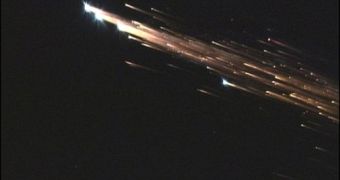Scientists recorded fervently as the first Automated Transfer Vehicle (ATV) re-entered orbit and burned in the atmosphere. Following a completely successful mission that started on March 9, the first European space craft of this class was plunged into a controlled dive over the South Pacific, where most of the debris that came from orbit is now to be found.
The ATV Jules Verne, weighing 17 tones, linked up with the International Space Station (ISS) in early April, delivering much-needed food, water and technical equipment. Jean-Jacques Dordain, director of the European Space Agency (ESA), announced at the International Astronautical Congress in Glasgow, Scotland, that the mission was a tremendous success. He highlighted the fact that during its docking period on board the ISS, the Jules Verne module successfully managed to propel the entire station out of the way, as some debris flew by very close, probably from a dismantled Russian satellite.
Unlike other supply modules, the ATV series is not designed for reuse or to sustain re-entry. In light of this, the ESA administration decided to destroy the craft in a controlled environment, over the deserted waters of the Pacific. A group of scientists observed the fall of the ATV, in hope that they could better understand the way meteors disintegrate in the upper layers of the atmosphere, due to intense heat. The bright traces the module left behind could prove to be consistent with other previous astronomical observations. The craft burned completely, leaving little debris for technicians to recover and study in the lab.
Bystanders witnessed fireworks similar to those left behind by the Russian MIR space station, when it was decayed from orbit and forced to enter Earth's atmosphere in 2001. With the American shuttle program due to be closed in 2010, the ATV class modules will be the sole carriers of supplies on board the $100 billion orbital station.

 14 DAY TRIAL //
14 DAY TRIAL //